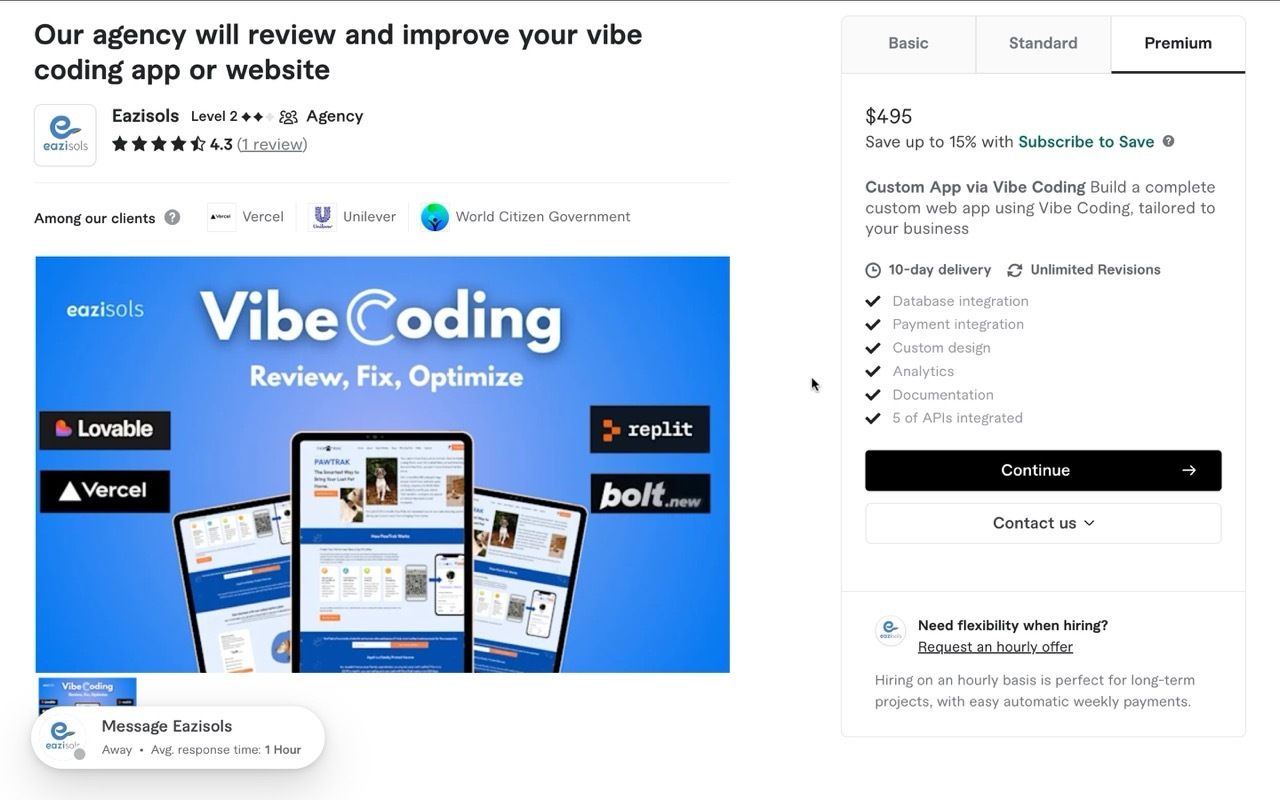- AI @chatgptricks
- Posts
- Fiverr + Vibe Coding = Micro-SaaS
Fiverr + Vibe Coding = Micro-SaaS
How to launch your own software for cheap

Last week I asked Reddit if anyone was using vibe coding to build a real business.
While a lot of people attacked, saying most of the stuff you see on social media is hype (which in many cases, is true), one response blew my mind.
The guy explained how he turned vibe coding into a systematic pipeline for launching micro-SaaS tools. And not just as a hobby either. His apps were generating revenue.
So I turned his comment into a five-step process for taking your rough Replit / Lovable vibe coding project and turning it into a software you can sell.
Step 1: Vibe Code v1
Start messy.
Doesn’t matter if you use Replit, Lovable, or whatever AI coding tool gets you excited.
Your goal isn't perfection here, you just want to get something that (generally speaking) works like the software you mapped out in your mind.

During this phase, you have to prompt/build until you hit the metaphorical wall (meaning no matter how many different AIs you ask, you start running into problems you cannot solve on your own).
You'll know you're there when the AI starts giving you convoluted solutions for basic problems. That's your signal to stop coding and start preparing to find a real dev.
Document everything that works, everything that breaks, and everything you wish worked differently.
This becomes your blueprint for hiring.
Step 2: Create the Perfect Hiring Package
Here's where most people screw up. They dump their rough code on a developer and say, "Make this work."

A vibe-coded project on Lovable
Instead, create what this Reddit user calls a "finishing specification":
Screenshots of your working features
List of bugs you've identified
Clear description of what "production-ready" means for your use case
Examples of similar tools (if they exist)
Think of yourself as a translator between the business problem and the technical solution.
Step 3: Find a Legitimate Developer
This isn't about finding the cheapest coder on Fiverr.
Instead, you need someone who specializes in taking rough prototypes to production.

Look for developers who mention:
"MVP optimization"
"Code cleanup and refactoring"
"Prototype to production"
Experience with your specific tech stack
Next, understand the best developers aren't necessarily the ones with 5-star ratings (most of which could have come from totally unrelated and/or amateur gigs).
So when you make it to this phase, look for people who ask detailed questions about the project before giving you a quote. And if you’re unsure of anything, ask ChatGPT (or your AI of choice):
What type of developer do I need for what I’m trying to do?
How much should I expect to pay them per hour / for the project?
How many hours should a project like mine take?
Etc.
Step 4: Structure the Handoff for Success
If you don’t have a tech background, one of the hardest parts about hiring developers is knowing whether or not you’re getting ripped off.
So, in addition to asking AI about your project, make sure you set clear expectations, budgets, and timelines upfront.
For reference, having someone convert your vibe coding project into an internal tool (e.g., an ugly but functional mini app, or Chrome Extension) should cost you around $200 to $800.
And if you want something that’s public-facing (meaning it has a working and aesthetically pleasing front-end), expect to pay around $500 to $1,500.
Second, for most projects, assume a 1-2 week turnaround time (which is exponentially faster than building a SaaS from scratch).

In terms of what deliverables to request, ensure you get the working code, basic documentation, and at least one round of revisions.
Step 5: Test, Launch, and Iterate
Once your developer delivers the polished version, resist the urge to immediately add new features.
Instead, test the core functionality with real-world users first. Your vibe-coded prototype already proved the concept works. The next step is to validate whether the polished version solves the problem it’s supposed to.

Meaning, now is the time to launch small and get feedback.
Feedback you’ll consider when it comes time to decide between investing in additional features or moving on to vibe-coding your next idea.
Vibe Coding vs SaaS Development
To highlight just how powerful this method is, consider what the OP said are the normal costs (pre-vibe coding) just to get a basic v1 micro-SaaS built:
Traditional development: $3,000 - $5,000 per tool
Vibe code + Fiverr dev method: $200 - $1,500 each
Time savings: 60-70% faster than traditional development

Vibe coding lowers production costs dramatically
Conclusion
The future of micro-SaaS isn't choosing between AI coding and human developers. It's using both strategically. You handle the business logic and proof of concept, a Fiverr dev takes your MVP and turns it into a functional v1.
Admittedly, you’re not going to build the next Hubspot or Slack this way.
But every day that goes by, I see X posts from the Build in Public community about how someone got their first sale - or hit their first $1,000 in MRR - with a tool they vibe coded. Which means, even if 50% of them are lying, there are still plenty of people using this method to lay the foundation for a profitable freedom business.
Interested in learning more about vibe coding and automations?
Make sure to join Sentient’s brand-new members community (it’s free : )
Catch you next time,
Louis & Ivan
ChatGPTricks Post of the Week:
What did you think?
Did you enjoy this newsletter blast? |
Want to connect with us? Send us a DM!


